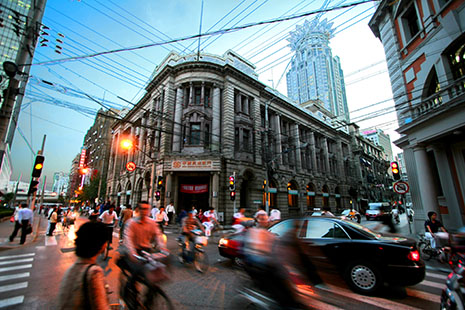CHINESE New Year in Shanghai arrives in the clouds of smoke and blazes of fireworks emanating from the old lanes and new residential neighbourhoods of this vast city of twenty million people. More noise comes from televisions tuned to China Central TV’s New Year’s Eve gala (estimated audience 700 million), a surreal mixture of the politically correct (dancers dressed as construction workers toting polystyrene bricks), the unashamedly populist (Hong Kong and Taiwanese popstars wishing the motherland a happy new year) and the downright bizarre (earnest army singers backed by male dancers in clinging pseudo-military fatigues apparently made of lycra).
Yet once the noise of the first evening or two (and the fourth, when residents welcome the God of Wealth with another barrage of firecrackers) has subsided, one of the nicest aspects of the holiday week is the sheer peace and quiet. Each year most businesses and factories, and many restaurants and shops, are closed for the best part of a week after millions of people leave town – for their homes around the country or, in the case of wealthier Shanghainese, for holidays in warmer parts of southern China or southeast Asia (or for mini-breaks in Paris, which were advertised this year too).
It all leaves the city feeling strangely empty, the air clean, the sky somehow higher and bluer. And it allows those who’ve remained behind to reclaim the streets for an activity to which Shanghai really ought to lend itself – taking a leisurely stroll in the old neighbourhoods and appreciating the city’s unique collection of historic and ultra-modern architecture. I say Shanghai “ought” to lend itself to such pursuits, because in practice it’s not quite so easy: on a normal working day the streets are a maelstrom of traffic, with frustrated drivers hooting frantically in the city’s ever-growing traffic jams, swerving from lane to lane in an effort to save an extra second or two, and screeching to a halt to avoid cyclists and pedestrians who launch into a stream of oncoming traffic without a glance left or right.
The pavements are not much better. The increasingly popular electric bicycles, which can travel at around sixty kilometres an hour without making a sound, not only shoot out of Shanghai’s old residential lanes without slowing down but often drive down the pavements. They do this partly because bike lanes have been removed from some of Shanghai’s major roads to ease the flow of cars, and partly because the cyclists themselves feel safer that way. Add to this the fact that those cyclists and motorcyclists who do stick to the roads seem to have decided recently that there’s no need to stop at red lights if no police are in sight and a short walk can be a traumatic experience. And that’s without even mentioning the conflict caused by traffic regulations that allow cars to turn right at junctions even when there’s a red light and pedestrians face a green walk sign.
The problem has become significantly worse over the past two or three years. Partly, it’s the increasing number of vehicles on the road: although Shanghai tries to limit the number of new cars by auctioning a set number of licence plates every month, it still adds up to some seventy thousand a year, and many drivers add to that figure by getting their cars registered in nearby cities. This also means a lot of new, inexperienced drivers. And then there’s the growing pace of life and financial pressures, manifested in hyped-up migrant truck drivers and delivery men who work long hours, desperate to reach their destination as fast as possible, and taxi drivers who will work up to twenty-four hours non-stop to pay the high fees demanded by their employers.
Shanghai isn’t alone in this respect. Traffic, and its impact on the quality of city life, is an increasingly contentious and politically charged issue in most Chinese cities. Over the past couple of years traffic accidents have become a major topic of debate nationally. One of the most talked-about incidents last year was a hit-and-run incident that killed a student on a university campus in northern China. When accosted by witnesses the driver tried to leave the scene in his Volkswagen, shouting that his father was a local police chief. Amid public outrage, he was jailed for six years. In other similar cases, rich youths or well-connected officials have tried to get away with murder, almost literally, after serious traffic accidents.
The public anger at such incidents stems partly from a general dissatisfaction with China’s growing wealth gap and the abuse of influence by the rich and well-connected. The general level of public awareness about road safety in China may still appear to be low – families often let their (only) child ride in the front seat without wearing a seatbelt, for example. But concern about safety is growing, which is hardly surprising in a nation whose many poorer urban residents often have to let their children spend most of the day playing on the sidewalk, and where traffic accidents are, according to state media, “the leading cause of death among people aged forty-five and younger.” (Some 16,000 children under the age of fifteen are killed or injured in road accidents every year, according to official figures.)
The effectiveness of the government’s efforts to improve road safety is debatable. While gruesome signs showing photos of previous traffic accidents can be found on the roadside in some inland provinces, basic steps, like a law to enforce the wearing of seatbelts in the back seats of cars, have yet to be taken. Pedestrians’ rights often seem to come last. And while official police statistics show that deaths in traffic accidents fell 27 per cent between 2002 and 2007, declining to 67,000 in 2009 (a relatively low number for such a large developing country), a recent study by researchers at Johns Hopkins University in the United States, based on death certificates, suggests that the true number of deaths on China’s roads may be almost three times that figure.
While the government talks a lot these days about people-centred policies, official awareness of the issue often seems low. During Shanghai’s massive makeover for last year’s World Expo, it was not uncommon to find pavements on both sides of a street being renovated at the same time, forcing pedestrians and older people in wheelchairs to weave their way through the traffic. When I asked one Shanghai government official about the increasing danger of the city streets recently, he seemed surprised. Perhaps you don’t do a lot of walking around these days, I suggested. I suppose that’s true, he said, with an apologetic smile, before getting back into his black chauffeur-driven sedan and speeding away.
IT’s a reminder that, even in these days when Chinese officials talk a lot about paying attention to public opinion on the internet (and there’s a lot of opinion out there), the message can still take a long time to get through. (Government by internet might also, by definition, involve reacting to issues only when they have already reached a fairly extreme degree of seriousness.) Some ordinary people seem to have become so fed up with the lack of official action that they have tried to take the law into their own hands – literally, in the case of a school in Shandong province, which bought police uniforms for two of its physical education teachers, and had them stand “on duty” at the school gates at the end of each day. The headmaster told Chinese media that he had no alternative since the local authorities had refused to install traffic lights or station real police officers on the road. Sometimes the actions have been more dramatic: a seventy-four-year-old man in northwestern Gansu province became an unlikely hero a couple of years ago when he started throwing rocks at drivers who ignored the lights and pedestrian crossings at a junction near his home.
Ironically, last year’s Shanghai World Expo, with its theme of better urban environments, seems to have given the green light to a string of articles in China’s media criticising the quality of urban life. Similarly, some fed-up urbanites are threatening to vote with their feet. On a recent trip to Beijing I was struck by the fact that a number of real “old Beijingers,” the kind who normally grumble about their city but will always defend it against criticism by outsiders, were talking seriously about moving out of the city, bemoaning the fact that the traffic is now often gridlocked even at weekends. Even the expanding underground rail network faces massive rush-hour overcrowding.
To be fair, Beijing has finally announced measures in the past few months to try to limit the ever-growing number of cars on its roads (the total has almost doubled over the past five years, reaching 4.7 million by the end of 2010, with an estimated 2000 new cars hitting the roads every day). It’s due to follow in Shanghai’s footsteps and bring in a limit on the number of new licence plates issued each month. It was notable that at the closing forum of the Shanghai Expo the city’s former mayor, engineer Xu Kuangdi – a respected graduate of the London School of Economics who oversaw much of the city’s development in the 1990s – criticised Chinese city planners for being obsessed with building ring roads regardless of whether they are appropriate.
The Expo did provide some alternative visions of urban organisation. Denmark’s pavilion, for example, attracted much attention by offering its visitors trendy modern bicycles to ride, at a time when many in China are dreaming of throwing away their bikes and replacing them with cars (or at least electric bicycles). And Expo’s chief planner, a German-trained urban planner, used the event to persuade officials to introduce a massive expansion of the city’s subway network years ahead of the original schedule.
As a result, in the year running up to the Expo, Shanghai opened six subway lines and extended several others, overtaking London as the home of the world’s largest urban rail network. This network, and the city’s experiment with park-and-ride projects and even downtown bicycle rental, will make it easier for people who live in Shanghai’s many new suburbs to leave their cars at home for their daily commute. But in a country where the growing love affair with the car has gone hand-in-hand with a general obsession with speed, modernisation and “progress,” it may be hard to change attitudes in a hurry. It remains to be seen whether the planners will get to grips with China’s traffic problems in a fundamental way any time soon – or whether we’re likely to see more citizens taking the law into their own hands… and resorting to throwing rocks. •




